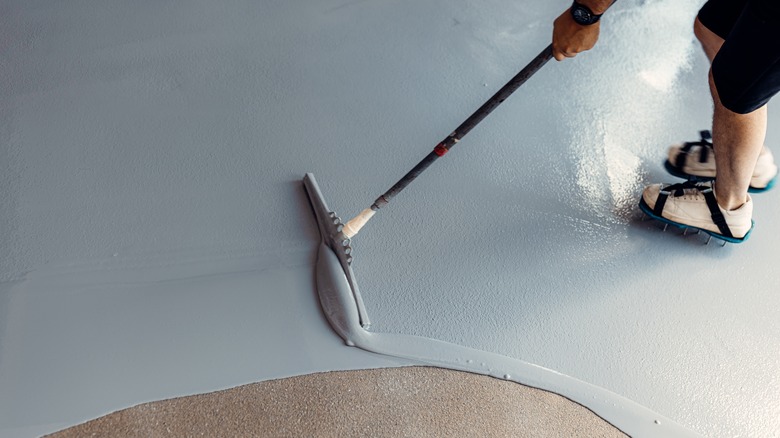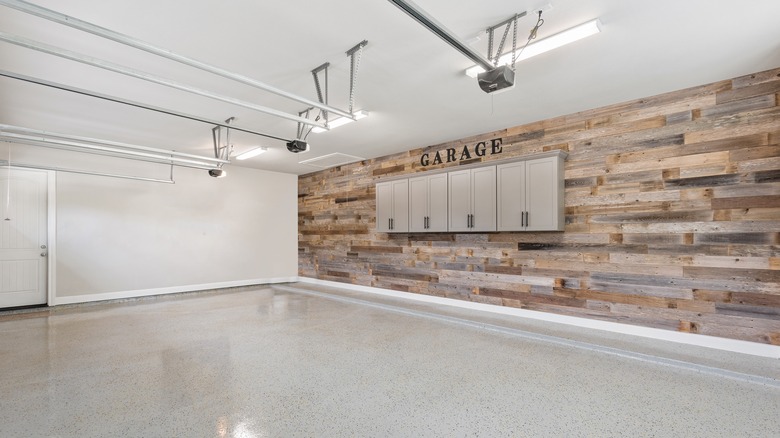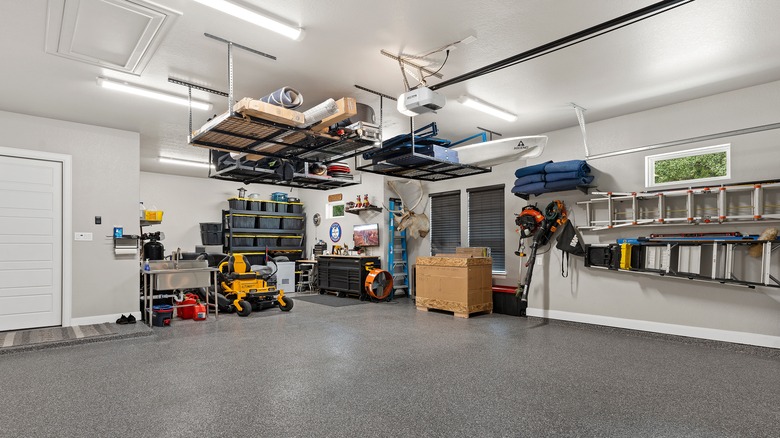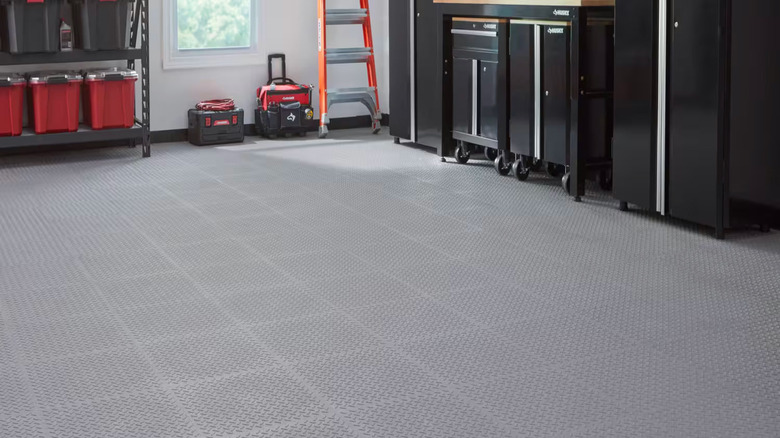The Best Types Of Paint To Use On Garage Floors (& Which To Avoid At All Costs)
We may receive a commission on purchases made from links.
Better, not bigger, is one of the top design trends in 2024. According to a recent study by the National Association of Home Builders, homeowners are placing higher value on superior finishes and less on square footage. This is especially the case for one of the most popular, if underrated, rooms in your house: the garage. From customizable storage solutions to high-end floor coatings, a neat and well-organized garage can make your home safer and more functional. A typical garage sees not just vehicular traffic but also motor oil leaks, rusty paint cans, and outdoor debris that leave your floors looking gross. Although it's tough and durable, concrete is also very porous, which makes it prone to staining. If you want your garage floors to look like new, you need to know the best types of paint to use — and which to avoid.
There are a lot of DIY garage flooring hacks out there. But painting is a more involved process that requires prep work, precise application, and drying time. You need to clean the concrete, repair any minor cracks or chips, and tape it off like you would before painting drywall. Then, you need to etch your garage floors with an acid-based product to create a rough texture so the paint bonds to the surface. No matter how well you prep garage floors for painting, though, it's critical that you select the best paint for the job.
Two-part epoxy is a common choice for painting garage floors
After prepping your garage floor and coating it with primer, you'll need to apply a paint that can withstand heavy traffic, along with changing temperature and humidity levels. You'll find a variety of options at your local home improvement stores, but many experts agree that two-part epoxy paint is best because it provides superior durability that can last for years. These products are made by combining resin and hardening chemicals that react to create a sleek, rock-hard finish. Once mixed, epoxy coatings must be quickly applied in a very well-ventilated space. They have to dry for at least 24 hours before being walked on, and for several days to a whole week before being vehicle-ready. More expensive than some other options, two-part epoxy kits can range from $200 to $800 for a two-car garage, but Car and Driver says the durability is worth the pricey investment.
A higher price tag and long curing time aren't the only disadvantages to using epoxy paint on your garage floors. If you start with concrete that has significant cracks or chips, the slick finish will only serve to highlight imperfections. In addition to making your garage floors dangerously slippery, epoxy finishes trap moisture that can cause both aesthetic and adhesion issues over time. As one of the most durable garage floor paint options out there, this becomes a double-edged sword if you ever need or want to remove two-part epoxy to change the color or fix issues that occurred during application.
Polyaspartic coatings are becoming more popular, but they're more costly too
Polyaspartic garage floor coatings are growing in popularity because they penetrate into concrete, providing excellent durability with much shorter cure times than epoxy. Along with polyurea paints, they're a subtype of polyurethanes, so you might see one of these names or a combination thereof on any given product. Like epoxy, they don't cover cracks or hide greasy stains, but they do offer application flexibility and UV stability. The experts at Garage Flooring LLC recommend etching or grinding to prepare your garage floor before applying polyurea, which the company sells in kits ranging from $185 to just under $1,750. Available with or without flakes that add texture, using polyurea results in a glossy finish that lasts up to 15 years.
If your goal is to help your garage live up to its potential, you may want to leave polyurea applications to the pros. Along with quick drying and curing times, this type of garage floor paint has a strong chemical smell. It should only be applied in well-ventilated spaces while wearing a respirator.
Don't confuse a true polyaspartic coating with polycuramine products like the Rust-Oleum RockSolid kits available at home improvement stores. Starting at $199, this self-leveling product has a different chemistry that RockSolid describes as a proprietary blend of epoxy, polyurea, and urethane. The company claims it's 20 times stronger than epoxy, but reviews are mixed. According to the experts at All Garage Floors, "it's also not nearly as resistant to abrasion as most polyurethane or polyurea coatings."
Avoid water-based paints — and consider interlocking floor tiles
No matter how tempting it may be to paint your garage floors with that can of leftover wall paint that's just sitting there, don't do it. One of the most common mistakes everyone makes when buying paint is not picking the right type for your project. Water-based latex mixtures and even products marketed specifically for garages may look good for a minute. But within a few days or weeks, the heat from your tires combined and the porous quality of the underlying concrete will create cracks, chips, and peeling paint. Before long, you will have to strip the paint, redo all of your prep work, and repeat the process with a product designed specifically for garage floor applications.
To avoid the hassle of picking the right paint for your garage floors, there is another option you may want to consider: interlocking floor tiles. These are available from home improvement stores in a wide variety of colors, designs, and materials including PVC and rubber. Easy to install with or without adhesive, floor tiles are a fast way to change the look of your garage while adding some insulation and acoustic benefits. They won't fix any concrete cracks, but they do provide some level of protection from future wear and tear, so they're a nice alternative to painting.



